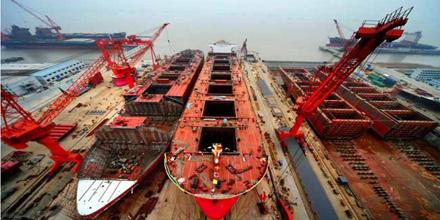Why Bangladesh’s Shipbuilding industry struggling to grab the global market?

Bangladesh’s Shipbuilding industry carries a rich, layered history, a proven capacity for competitive pricing, and a workforce attuned to the craft of ship construction, yet the country has failed to translate that promise into a sustained, large-scale presence in world markets. More insights on global industry trends can be found at World Bank.
This long-form look traces how a sector that rose from traditional boat making to ocean-going exports stumbled on regulatory, financial, and technological hurdles, compares Bangladesh with dominant rivals, and outlines an actionable way forward for policymakers, yard owners, financiers, and exporters. For context on global trade dynamics, visit WTO.
A long tradition turned industrial
Shipbuilding in the territory that is now Bangladesh goes back centuries, when riverine communities built wooden boats for trade, fishing, and transport, passing down techniques across generations. In the late 20th century traditional skills met industrial ambition. Modern yards such as Ananda Shipyard and Shipways Limited, Western Marine, and others emerged on the banks of the Meghna and Karnaphuli rivers, transforming backyard craft into steel-hulled vessels. Additional regional history is available at Britannica.
In 2008, Ananda Shipyard delivered Stella Maris to a Danish buyer, the first ocean-going export that put Bangladesh on international shipbuilding maps. That shift proved the country could meet foreign buyer requirements and achieve class approvals for oceangoing vessels, marking an important milestone for the Shipbuilding industry. Learn more about classification standards at DNV.
Measured growth, but exports remain small compared to potential
Since the first exports, a handful of Bangladeshi yards secured contracts for coasters, small container feeders, bulk carriers, passenger ferries, and offshore service vessels, selling to buyers in Europe, Africa, and Asia. The sector grew into a cluster of more than a hundred yards serving domestic and international demand, with a mix of private and state-owned facilities focused on various vessel sizes and market segments. International shipping data can be explored at UNCTAD.
Public trade statistics show Bangladesh’s export basket has diversified, but ship and boat exports remain a relatively small slice of national exports, and the value captured internationally falls far short of what many analysts estimate as Bangladesh’s potential in select segments of global demand. Export data references available at Trading Economics.
Global landscape
Globally, shipbuilding is highly concentrated, dominated by a few East Asian nations that control the lion’s share of new orders for large commercial vessels. China, South Korea, and Japan together account for the vast majority of newbuilding tonnage and orderbook value, driven by state-backed industrial policy, integrated supply chains, huge steel and component industries, and yards that specialize at scale. Global shipbuilding rankings can be seen at Clarksons Research.
This concentration leaves small exporters like Bangladesh competing in specialized niches or on price for smaller, less complex vessels. The global imbalance and aggressive state support for large yards make it difficult for Bangladesh’s Shipbuilding industry to climb into higher value segments. A comparative overview is accessible through OECD.
Limited scale and specialisation
Bangladeshi yards built their early reputation on small to medium coastal vessels and certain offshore service craft, where labour intensity and competitive pricing provided an edge. However, the global market rewards scale, standardisation, and the ability to deliver very large, technically complex ships such as LNG carriers, very large container ships, and sophisticated naval platforms. More on vessel categories is available at Marine Insight.
Most Bangladeshi yards lack the acreage, heavy lifting capacity, and production lines needed to produce these vessels competitively, which limits the Shipbuilding industry’s addressable global market and forces yards to compete in crowded, lower-margin niches. Industry challenges are outlined at IHS Markit.
Finance, credit and working capital gaps
Ship construction is capital intensive, requiring long lead times, large upfront steel and component purchases, and bridge financing while yards deliver over months to years. Many Bangladeshi shipbuilders face restricted access to long tenor shipbuilding finance at competitive rates, and domestic banks often view yard lending as risky. Financial context available at IMF.
This financing gap translates into higher costs for buyers or the need for shorter payment terms that make bids less competitive. Without steady, affordable credit lines tied to export orders, yards cannot scale production, invest in modernization, or offer attractive delivery schedules, which weakens the Shipbuilding industry’s competitiveness. Learn more about export finance at EXIM Bank USA.
Standards, classification and aftersales concerns
Global buyers require vessels classed by internationally recognised classification societies and expect consistent quality and robust warranty, spares and aftersales support. While a few Bangladeshi yards have successfully obtained approvals and delivered classed vessels, inconsistent quality control at other yards has created perception risks. Classification info at Lloyd’s Register.
Meeting stringent international technical and safety standards requires investments in welding procedures, non-destructive testing, traceable supply chains, and documented quality management systems. Gaining buyer trust at scale is essential for the Shipbuilding industry to move beyond one-off deals and become a predictable supplier to discerning international ship owners. Certification details at ABS.
Supply chain and domestic input constraints
Large scale shipbuilding depends on a mature domestic supply chain for marine grade steel, outfitting components, engines, propellers, and electronics. Bangladesh lacks many upstream suppliers at the scale and certification levels required by global yards, meaning shipbuilders often import critical components, raising costs and creating vulnerabilities to foreign exchange swings and logistics delays. Learn about supply chain principles at Supply Chain Digital.
Developing domestic suppliers, or forming reliable regional sourcing partnerships, would reduce lead times and costs, improving the Shipbuilding industry’s ability to price and deliver competitively. Supply chain improvement examples can be found at McKinsey.
Skills, productivity and technology
Although Bangladesh has a tradition of skilled craftsmen, modern shipbuilding demands different competencies as production shifts toward modular construction, computer aided design, and digital yard management. Productivity at top South Korean and Chinese yards results from process engineering, automation, and continuous improvement, not merely labor hours. More insights at BCG.
Bangladeshi yards need structured workforce training, certified welding and fabrication programs, and investment in productivity-enhancing tools to close the gap in unit labour costs and quality assurance. Without that, the Shipbuilding industry remains handicapped when bidding for larger, higher-tech contracts. Training models found at ILO.
Policy, incentives and coordination
Countries that dominate shipbuilding often provide a coordinated policy package that includes export credit schemes, tax incentives, infrastructure investment, and strategic procurement. Bangladesh has supported the sector sporadically, but lacks a comprehensive industrial strategy that aligns incentives, regulatory reform, and investment promotion specifically for ship exports. Global policy examples available at UNIDO.
A fragmented policy approach leaves yards to fend for themselves in obtaining long-term finance, land, and port access, limiting the Shipbuilding industry’s capacity to scale rapidly. Economic policy comparisons at ADB.
Reputation and market positioning
Reputation matters in shipbuilding, where orders are large and owners want predictable performance. Early successes for Bangladeshi yards opened doors to buyers in niche markets, but inconsistent delivery experiences by some firms, and limited marketing sophistication, reduced repeat business.
To compete, the Shipbuilding industry needs sustained brand building around a narrower set of export specialisms, shifting from a “low-cost” pitch to a reliability and value proposition for particular vessel types. Marketing strategies available at Forbes.
How Bangladesh compares with competitors?
Comparing Bangladesh with South Korea, China, Japan, Turkey and Vietnam shows stark differences in scale, government backing, and value chain integration. South Korea and Japan capture high-value segments using technological leadership and large captive suppliers, China dominates in volume with cost advantages and expanding state support, while Turkey and Vietnam occupy middle segments with focused strategies on certain vessel types. Comparative data at Statista.
Bangladesh’s relative advantage lies in labour cost competitiveness for smaller vessels and flexibility to customise for niche buyers, but these advantages shrink as automation and global competition evolve. To move up the value chain, Bangladesh must choose focused niches where the Shipbuilding industry can leverage low cost labour plus targeted technical upgrades, rather than attempting to match the scale of East Asian giants. Labour data at ILOStat.
Opportunities that can be leveraged
There are practical market windows where Bangladesh can realistically expand exports. Demand for small feeder container ships, coastal tankers, offshore service vessels, ferries and customised barges remains healthy across Africa, Southeast Asia and parts of Europe, and some buyers prefer specialised yards with faster customization. Vessel demand trends at MarineTraffic.
Green transition in shipping, such as retrofits for dual-fuel systems and small-scale alternative propulsion, creates specialised demand where nimble yards can offer tailored solutions. Domestic economic expansion and port development also guarantee local vessel demand, which can underpin steady order books and learning-by-doing for export grade builds. If the Shipbuilding industry targets these niches with consistent quality, it can build a reputation and scale gradually. Green shipping info at IMO.
Concrete way forward, practical and policy-driven
A pragmatic path for Bangladesh’s Shipbuilding industry requires coordinated action across six fronts. First, create export-linked financing instruments that tie low-cost, longer tenor loans to confirmed foreign orders, supported by export credit guarantees. Second, invest in yard modernisation grants and tax incentives for capital equipment that raise productivity and quality. Third, establish accredited training institutes for modern shipbuilding skills and welding certification, in partnership with leading classification societies. Fourth, nurture a domestic marine supply chain through supplier development programs and trade facilitation, lowering import dependency. Fifth, adopt a focused marketing strategy, promoting Bangladeshi yards for specific vessel types where they can win reliably, rather than competing across all segments. Sixth, streamline regulatory processes related to land, dredging, and port services to reduce lead times and logistical friction. Policy frameworks at World Economic Forum.
These practical measures would let the Shipbuilding industry convert latent potential into steady, higher value exports. Export strategy guidance at ITC.
Case examples show what focused strategy can achieve
Lessons from yards that successfully exported to Europe demonstrate that certified processes, transparent contracts, and predictable delivery schedules win repeat buyers. A few pioneering Bangladeshi builders invested early in certification and stringent quality processes and as a result secured multiple orders from European and African owners. Maritime case studies at Lloyd’s List.
By packaging these operational best practices and replicating them across clusters, the Shipbuilding industry can scale trustworthy export capacity. Industry transformation insights at PwC.
Risks and realistic timelines
Even with bold reforms, progress will be incremental. Building confidence among large global ship owners and classification societies takes several consecutive on-time, on-budget deliveries. Structural limitations in steelmaking, heavy fabrication, and high-value component manufacture mean Bangladesh will likely remain a specialist for the near future. Shipping forecasts at BIMCO.
However, the country can carve meaningful export share in selected vessel categories within five to ten years, provided policy, finance and skills align behind a clear industrial strategy for the Shipbuilding industry. Economic predictions at OECD Data.
Recommendations for stakeholders
Yard owners should prioritise certification, standard operating procedures, and modular construction techniques that reduce on-site complexity. Banks and financiers must design shipbuilding finance products aligned to export cycles. Guidance on yard modernization at Ship Technology.
The government should formulate a targeted shipbuilding export policy with incentives for modernization and supplier development. International development partners and export credit agencies can support early de-risking of pioneering contracts, helping the Shipbuilding industry demonstrate repeatable success. Policy tools at UNDP.
Bangladesh’s Shipbuilding industry entered the international arena
on the back of traditional craftsmanship, entrepreneurial yards, and competitive labour costs. The country has already proven it can deliver ocean-going ships on occasion, but systemic barriers have constrained a sustained global breakthrough. Industrial insights at Industry Europe.
Overcoming limited access to finance, supply chain weaknesses, certification gaps, and modest scale will require coordinated policy action and private sector investment. If stakeholders commit to a focused, pragmatic strategy that marries the sector’s human capital with modern standards and export finance, the Shipbuilding industry can move from episodic wins to a durable, export-oriented chapter in Bangladesh’s industrial story. More analysis at Brookings.






